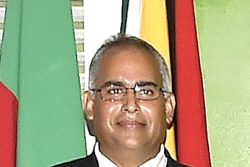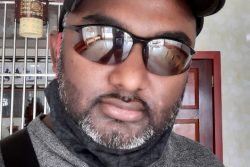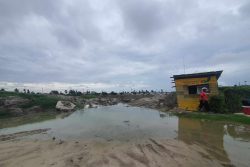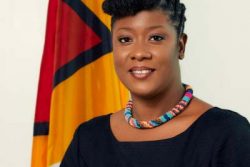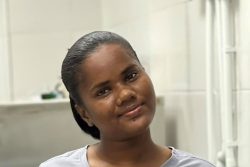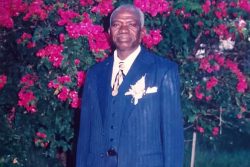This concludes Akima McPherson’s conversation with Guyanese artist Dudley Charles. Charles, a self-taught artist, who was born in 1945, has been painting for at least 60 years and has exhibited his work in several countries around the world. The conversation has minor edits for clarity.
DC: When I was introduced to acrylic paints I used to go to a place on Water Street to buy them. Most of the artists were interested in oil except Leila [Locke] and Ron [Savory]. [But] oils would take a long time to dry and I didn’t like the smell of the turpentine… so I used to get frustrated, very frustrated. I used to get a tube of acrylics for 15 cents when on sale, or 35 cents [when not on sale].
AM: That was cheap?
DC: To me, yes. It was cheaper plus I didn’t need to get turpentine and linseed oil. There was real excitement when we became a Republic. There was an exhibition of works in the National Collection at the Guyana Museum. And artists were invited to submit a piece. My work was totally different from anything there. I used string and other material. I was experimenting with strange objects [in the paint]. I started that in the 1960s. […] In the back of my mind, I was interested in painting and the idea of illusions – of things coming forward, going backward, and disappearing… so when people look at the work they can feel like they were inside it. The young artists had landscapes and they looked beautiful. And I figured a lot of them thought what I was doing was foolishness.
AM: I know that feeling.
DC: And I sensed that in their conversation. But I knew what I was doing and that I wanted to be the best young artist… a very bold thing to say, I guess. Philip [Moore] asked for me to help him. There was a cultural association run by Eusi Kwayana. I think he was going by that name then. I was a member of the group. I was into cultural matters. Philip knew me from there and Donald’s group, so he recommended me.
AM: What did he recommend you for?
DC: Programme Assistant for Art; what he used to do.
AM: Philip was Programme Assistant for Art?
DC: Yes. Lots of people were there – Sheik Saddiq for literature, Gobind Ram for Indian music and cultural events [he mentions other names I don’t manage to record]. I got more confident then. I felt I needed to do more than I was seeing in Guyana. I had to paint my story. And remembering Donald’s talks about the history of art, I felt more confident. In European art, they were telling their story. I didn’t want to paint [an] ordinary landscape. I didn’t want to do it that way. So, I started thinking about my story … like I said, Jumbie story, Baccoo.
[He chuckled]
Then Denis Williams came to work at the Department of Culture in 1974. I had already started working on the Old House series. The thing about Denis, he’d look. He didn’t use to say anything. He would just look. And then when I was preparing the Solo Exhibition he saw how I named the work – Old House #1 and he suggested Image: Old House #1. He recognised each was a separate story and when I was finished, I was finished.
Donald was building up the canvas and that was interesting. But my interest was really with Leila and the depth of the colour.
[..]
AM: When did you start getting as textural as you are with your current canvases?
DC: When I came over here.
[We both laugh. I had told him in a previous conversation I suspected his current canvases got so because he had access to paint.]
DC: I realised I have materials. I could experiment more. I had freedom. I would go to the art supply store and buy paints by the gallon and gels, so I got back into the way Donald used to show me to work, but I was still interested in colour. The artists in Guyana need to experiment more. They could experiment with subjects. They don’t even have to use a lot of colour or paint.
AM: In our conversations, you keep going back to art history. That impresses me. As an art historian and someone who teaches art history to aspiring artists I always have to convince them that they need to know art history because there are things to be learned to develop their practice.
DC: You are correct. You said it there. You need to know what has been done so it can guide your experiments. I know some of the guys when they look at a Frank Bowling work they may think it’s just about colour but it has a strong under-drawing quality.
AM: Explain that to me because I admit when I think of Bowling I think of colour and texture, water and evocations of water, and memory of Guyana. I don’t automatically think lines.
DC: His work has a drawing quality not in the sense of using charcoal or the pencil but it’s in the brush. How he moves the brush.
AM: Ah, Yes. I’m thinking of some videos I have seen of him in the studio. He’s pushing the brush around or guiding someone to do so and that is what the brush does. It makes lines. But I guess he builds up the canvas so much that sometimes you lose the line.
[I grab the monograph produced for Bowling’s Tate 2019 exhibition. I turn the camera on and turn the pages. We look together. I see the lines before colour. They are everywhere. Literal lines are obliterated by overlays of amorphous masses of colour.]
——
We agreed to chat again soon. He is excited to go into his studio and paint. I am tempted to ask what he is working on. But these are stolen moments to return an overdue call. I feel honoured to go down memory lane with one of my favourite artists and friends. From this and our last conversation, I realise there is a line to be drawn between him and Leila and I wonder who else. I have a vague recollection of George Simon saying to me that he was influenced by Charles when I questioned him about being influenced by Wifredo Lam (Cuba). But it is a vague memory and he has passed on. I wonder about Simon’s archives and what they may reveal.
Akima McPherson is a multimedia artist, art historian, and educator.


